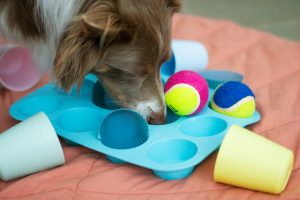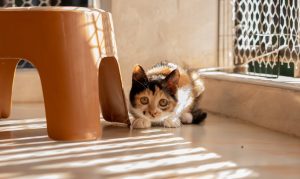
15 Powerful Ways to Pet Proof a Small Balcony Without Losing the View
Balconies are one of the best features of apartment living—especially if you have a pet who craves fresh air and sunlight. But without proper precautions, a small balcony can pose serious risks for dogs and cats alike. From accidental falls to toxic plants and chewable cords, the hazards are real—but the good news is that you don’t have to sacrifice your outdoor space to keep your pet safe. These powerful strategies will help you pet proof a small balcony while still enjoying your view, your light, and your peace of mind.
1. Install Pet-Safe Mesh or Netting Along the Railing
One of the most effective ways to pet proof a small balcony is by adding durable mesh or netting around the railing. This creates a barrier that prevents your dog or cat from slipping through slats or climbing between bars. Look for mesh labeled as UV-resistant and chew-resistant, and make sure it’s tightly secured from floor to rail with zip ties or adhesive hooks. Products like catio netting or balcony guard screens work great without blocking light or airflow.
2. Use a Portable Catio or Collapsible Balcony Enclosure
If you want total peace of mind, a portable catio or zip-up mesh enclosure creates a fully contained outdoor space for your pet. These are ideal for renters because they don’t require drilling and can be folded and stored when not in use. The team at Catiospaces offers DIY and prefab solutions that fit even the narrowest apartment balconies. Most versions are lightweight, UV-resistant, and provide plenty of ventilation without sacrificing safety.
3. Install a Jackloc or Window-Style Safety Restrictor
If your balcony opens with sliding doors or windows, a product like the Jackloc system can prevent your pet from pushing their way through. These safety locks can restrict openings to just a few inches—enough to enjoy airflow without allowing room for a curious cat or dog to escape. They’re renter-friendly, non-permanent, and especially helpful for balconies in high-rise buildings or apartments with toddler-height ledges.
4. Elevate Toxic Plants or Replace Them Entirely
Many popular balcony plants—like lilies, aloe, azaleas, and pothos—are toxic to pets if chewed. Cats and dogs may investigate pots out of boredom or curiosity, putting them at serious risk. To pet proof a small balcony safely, move hazardous plants to wall-mounted planters, hanging baskets, or upper shelves that are totally inaccessible. Alternatively, swap them for non-toxic greenery like spider plants, wheatgrass, or bamboo palm. Be sure to check the full list of safe and dangerous plants via the ASPCA Animal Poison Control guide. When in doubt—keep it out.
5. Add Soft, Non-Slip Flooring to Cover Gaps and Heat
Standard apartment balconies often have rough concrete, tile, or metal slats that can become painfully hot—or dangerously slick—under paws. Adding pet-safe flooring like interlocking outdoor foam tiles, rubber mats, or synthetic grass turf not only improves comfort but prevents slipping, paw burns, and accidents. These are renter-safe (no adhesive required), weather-resistant, and easy to clean. Make sure the edges are flush so your pet doesn’t trip, and check for drainage holes if you live in a rainy climate. This is one of the easiest upgrades to improve both safety and daily enjoyment for your pet.
6. Create Shade with Pet-Safe Tents, Umbrellas, or Covers
Sun exposure can quickly turn a balcony into a heat trap. Give your pet a place to cool off by creating shaded zones using pop-up tents, waterproof fabric crates, or collapsible outdoor pet beds with built-in canopies. If your space is too tight for furniture, install a tension rod with a shade cloth or a UV-blocking privacy screen along one side of the balcony. These setups reduce overheating risk without blocking airflow or your view. Just ensure there’s enough ventilation and that your pet has access to both shade and water at all times.
7. Supervise Balcony Time and Use a Timer
No upgrade replaces supervision. Always keep an eye on your pet during balcony time—especially if you live above the ground floor or have a jumper. Even with netting and flooring in place, cats can climb unexpectedly and dogs can leap if startled. To avoid losing track of time, set a timer for 10–15 minutes as a reminder to check in or bring your pet back inside. Consider using balcony time as part of a structured enrichment session so your pet associates it with calm exploration—not high-energy play or anxious pacing.
8. Remove Climbable Furniture from Balcony Edges
It only takes one misplaced jump for a cat or small dog to land in serious danger. Avoid placing tables, shelves, or tall planters near balcony edges—especially if they can act as launchpads or platforms. Keep furniture anchored or centered away from railings. For small balconies, consider low-profile floor seating or a collapsible lounge mat for you and your pet to share without elevating risk. If your layout doesn’t allow it, add vertical netting to block access to the upper rail area.
9. Block Off Electrical or HVAC Equipment
Many apartment balconies include electrical boxes, HVAC units, or utility panels. These areas are often dusty, sharp-edged, and contain exposed wiring or chemicals that can harm curious pets. Use a tall, freestanding gate or a secure plastic barrier to block off access. If possible, surround utility components with planter boxes or covered shelving that deters direct interaction. Never allow pets to rest directly against hot AC compressors or chew on wires—even if they seem uninterested at first.
10. Use Privacy Screens for Wind and Noise Control
High-rise balconies often come with intense wind gusts or echoing noise from traffic below. Lightweight privacy screens made from bamboo, canvas, or UV mesh can help reduce these stressors while maintaining your view. Choose renter-safe installation methods like zip ties, suction hooks, or tension rods. In addition to keeping your pet calm, these screens prevent lightweight toys, bowls, or bedding from blowing off the balcony. Bonus: they also offer some visual protection from nearby units, giving your pet a sense of calm privacy while they relax outdoors.
11. Keep Toys and Water Low to Prevent Falls
Playtime on the balcony can be fun—until a ball rolls under the railing or a bowl tips near the edge. To keep things safe, always place toys, treats, and water bowls far from the balcony’s perimeter. Use non-slip mats or heavy ceramic dishes that won’t slide. You can also secure lightweight items in storage bins or trays with raised sides. For dogs, this helps prevent pawing items over the edge. For cats, it reduces temptation to chase rolling objects into risky areas.
12. Monitor the Temperature—Balconies Heat Fast
Even on mild days, balcony surfaces can get dangerously hot. Use a pet-safe thermometer to check surface and air temps before allowing access. Anything over 85°F (29°C) can be risky—especially for flat-faced breeds, seniors, and cats with dark coats. During summer, limit outdoor time to mornings or evenings. On sunny days, test the flooring with your hand; if it’s too hot for you, it’s too hot for their paws. Having water, shade, and a quick exit route is essential every time your pet is outside.
13. Practice “Leash and Lounge” for Dogs
Dogs who get overly excited by street noise or birds might need a little extra supervision. Try clipping their leash to a secure hook, railing, or heavy furniture while they relax on the balcony. This allows them to enjoy the space without wandering or jumping, especially in smaller balconies with minimal fencing. Just be sure the leash is short enough to prevent reaching the railing, and never leave a leashed dog unattended outdoors.
14. Create a Mini Enrichment Station Outdoors
Make the most of your balcony space by turning it into a low-stress enrichment area. Add a small digging box filled with safe substrate, puzzle feeders, or scent-marked toys to give your pet a reason to linger calmly. Rotate items weekly to keep things exciting and mentally stimulating. For cats, you can also mount a perch shelf or hang crinkle toys from overhead rails. This is a great way to extend indoor enrichment habits to your balcony space.
15. Use a Smart Camera to Monitor Balcony Behavior
If you allow solo balcony access (even for a minute), use a pet-safe smart camera to check on your pet in real time. These cameras can send alerts if barking, pacing, or unexpected motion is detected. They’re especially helpful for cats that like to sneak through gaps or dogs prone to digging or chewing. Choose a weather-resistant model that mounts inside facing out, or position it through the balcony door to capture a clear view. Monitoring helps you respond quickly if anything seems off—and gives peace of mind while you’re home or away.
Final Thoughts
Balconies can be a huge quality-of-life boost for apartment pets—if they’re set up with care. With these 15 pet proofing upgrades, you don’t have to choose between safety and sunshine. Whether you're working with a tiny ledge or a full wraparound balcony, simple changes like netting, soft flooring, and shaded hideaways can make your outdoor space safer, calmer, and more enjoyable for your four-legged roommate. Always supervise when possible, rotate enrichment, and prioritize safety—but don’t forget to sit back and enjoy the view together.
Frequently Asked Questions
Is it safe to let my cat or dog on a balcony?
It can be safe—but only with proper precautions. Use netting, restrict access to edges, and always supervise. Many balconies have wide gaps or exposed ledges that pose serious fall risks. Pet proofing is essential, especially in high-rise buildings.
What are the best renter-friendly ways to pet proof a small balcony?
Mesh barriers, shade cloths, portable catios, soft flooring, and zip-tied privacy screens are all renter-safe and removable. Avoid drilling or permanent installations—many products are tension-mounted or clip-on and designed specifically for rentals.
Can dogs or cats fall from balconies with railings?
Yes—accidental falls are a serious danger. Cats may misjudge jumps, and dogs can leap or slip between railing gaps. Even small falls can cause injury. Use vertical netting or balcony guard panels to prevent access to dangerous edges.
What temperature is safe for pets on a balcony?
Keep balcony temperatures under 85°F (29°C), and always check the surface with your hand or foot. Direct sun or concrete can heat up fast. Add shade, airflow, and fresh water—and limit outdoor time during peak heat hours.
Where can I buy a pet-safe balcony enclosure or netting?
Check out Catiospaces for prefab and DIY catios, or browse secure mesh and safety latches from Jackloc. These products are renter-safe and designed specifically to prevent accidents.

Join the Busy Pet Parent Newsletter!
Get easy routines, time-saving tips, and the latest gear reviews—delivered straight to your inbox.
Perfect for busy pet owners, apartment dwellers, and anyone who wants a happy, healthy companion (without the stress).
Exclusive guides & checklists
Product recommendations & deals
No spam—unsubscribe anytime!




